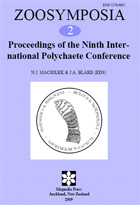Abstract
The nervous system of the ectoparasitic male of Scolelepis laonicola (Tzetlin, 1985), which attaches to the dorsal side of the female, was investigated by immunohistochemical methods in combination with confocal laser scanning microscopy. The male’s nervous system is reduced; no ganglia are found in the central nervous system. The circumesophageal connective is split into dorsal and ventral roots. Two median and one paramedial nerve run along the midventral axis of the male. The peripheral nervous system is well developed. Five commissures arise from each main cord per segment. There are two dorsolateral and two ventrolateral longitudinal nerves. The biggest segmental transverse nerve runs to the parapodia and diverges into a few fine nerves at the top of the parapodia. The nerve cord turns 90° in the male-female contact zone. Well-developed peripheral nerves, the presence of lateral nerves, and the absence of differentiated ganglia indicate the progenetic origin of the S. laonicola male. Well-developed parapodial nerves in immobilized mature males suggest an important role of the parapodia prior to settlement and possible presence of chaetae in the larva.

